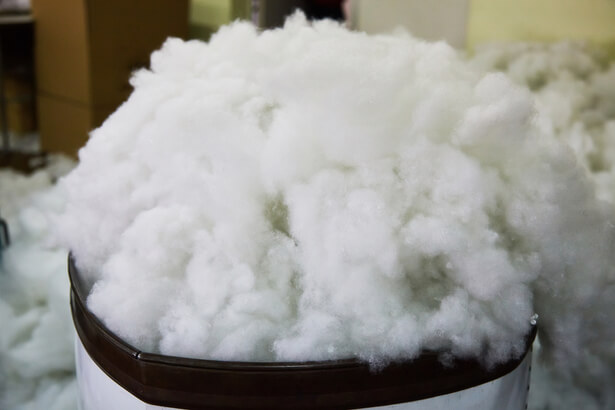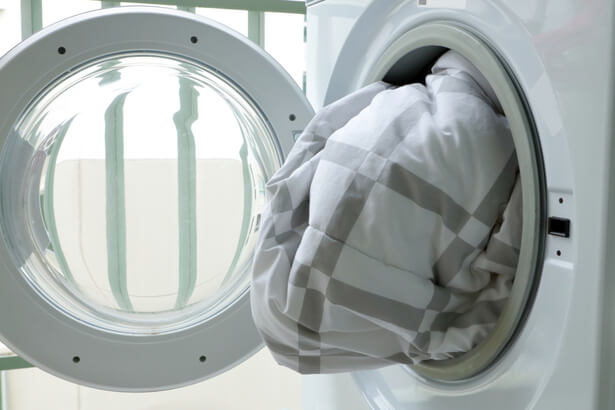When it comes to sleep, we often think about choosing pillows and mattresses carefully. But choose your duvet is also important: for restful sleep, you must feel good in bed, neither being too hot nor too cold. A good mattress, a good pillow and a good duvet are therefore the secrets to perfect sleep!
Choosing your duvet: our tips to avoid making a mistake
Before choosing the right duvet, ask the right questions. First of all, it is necessary to determine the size andwarmth rating of your duvet.
How to choose the right size duvet?
First step; determine the size that fits best. To do this, you must first know the size of your mattress. For better comfort, it is recommended to choose a duvet size larger than the mattress size.
It is important not to make a mistake in the size of your duvet ©fizkes
For example, if the mattress measures 140×190 cm, choose a duvet measuring 180×200/220. Likewise, if you tend to move around a lot at night or if your partner has a knack for taking up the whole duvet, choose a duvet much larger than the mattress. And if it is common for one of you to find yourself without coverage, consider individual duvets !
What heat index should you choose for your duvet?
Quilts are often presented with a heat index which can go from 1 to 4, (or even up to 5 or 6 depending on the brand) or temperate duvetlight, warm and very warm.
The choice then depends on two things:
- Are you the type who often feels cold, to be chilly even under the duvet ?
- Do you sleep in a poorly or highly heated room?
To make your choice, look at both the heat index and the weight of your duvet. The weight corresponds to the duvet filling weight. It can vary from 180 gr/m² for light blankets, to 500 gr/m² for the strongest winter duvets.
The choice of duvet weight is important. It is often considered that the heavier it is, the warmer it is. But you also have to think about your comfort. Some people need to feel the weight of the duvet » on their body to sleep well while others can’t stand it.
- THE light duvets and temperate are preferred if your room is heated to more than 20°C, if you tend to get hot very quickly, or if you are just looking for a light duvet for the summer.
- THE 3/4 warmth index duvets on a scale of 6, or so-called warm duvets should be chosen if your room is cool, or if it is heated, but you are the chilly type.
- The duvets with the highest warmth index, or so-called very hotare suitable for people who often feel cold, even under a blanket, whose room is not heated, or who need a warm and thick blanket for the colder months of the year.
Several duvets per year or an all-season duvet?
If you have space to store your duvets, it is best to choose a lightweight duvet for spring and summer and a very warm duvet for winter. This will also allow you to lower or even stop the heating in the room!
If you don’t have the space or budget to buy several duvets, there are also all season duvets. They are made up of 2 elements, a light one for summer, a thicker one to use in spring or autumn. The two can then be assembled to compose a ideal duvet in winter !
Natural and ecological duvet: what filling?
Once the size and heat index have been determined, you must choose the type of filling: natural or synthetic. For a ecological duvetwe recommend natural filling: here are the options you have.
Natural duvet fillings
THE natural fillings are appreciated for their power of insulation and thermal regulation. As a general rule, these fillings keep you warm in winter and provide some freshness in summer. Lightweight, the natural duvets are appreciated for their longevity.
Natural wool duvet
Soft, hypoallergenic and thermoregulatory, wool is very popular sinceit perfectly regulates temperature and humidity. This is no small thing when we know that an individual eliminates approximately 180 liters of water in a year while sleeping.

There are natural fillings ©ullision
On the other hand, the price of a wool duvet is very variable depending on the quality of the wool. Count between 110 and 300 euros for a 100% wool duvet.
Feather and down duvet
THE feather and natural down duvets are criticized by animal rights activists because of their origin. They are in fact made from the down of ducks or geese; However, they are light and warm, and allow air and humidity to escape.
Their faults: their animal origin, but also their high price and more difficult maintenance. It is important to air your duvet regularly, winter and summer, and prefer dry cleaning.
Natural silk duvet
THE natural silk duvets What is special is that the filling does not require any chemical treatment of the material. The fineness of this duvet in no way affects its thermoregulatory properties. In addition, the silk duvet is hypoallergenic and anti-mite.
Its price is also very high: you can count on up to 400 euros for a quality silk duvet.
The silk duvet can be machine washed, but requires a delicate cycle. Use few cleaning products and especially no bleach. Leave to air dry and lay flat.
Plant fiber duvet
Increasingly present on the market, plant fiber duvets are appreciated for their ecological and guaranteed aspect vegan. Bamboo fiber duvets are anti-odor, anti-humidity, antibacterial and anti-allergic. Corn fibers are hypoallergenic and thermoregulatory. However, be careful to choose bamboo fiber duvets and not bamboo viscose. These harder to find comforters are often more expensive.
Choose your duvet wisely: opt for a synthetic duvet filling?
Duvets with synthetic filling are more economical than natural duvetsand they are recommended for people with allergies. However, the quality of synthetic duvets is sometimes not there.
Mixed fiber duvets: a good compromise
Some duvets offer mixed fillings combining synthetic, artificial and natural fibers. They can be made from bamboo fibers, eucalyptus or wood cellulose (Tencel/Lyocell filling, Ingeo, etc.). It is a good compromise between the virtues of natural fibers and the technology of synthetic fibers. On the other hand, their quality can vary.

A polyester filling ©krolya25
Recycled fiber duvets
Today it is possible to acquire recycled fiber duvets (most often it is polyester). A good option for ecological duvet while avoiding animal origin. The problem: we are often little informed about the traceability of these recycled fibers.
Synthetic duvets: which fibers?
Regarding the synthetic duvetsthere are three types of fibers: full fibers, cheap, hollow fibers, more airy, and hollow silicone fibers, softer and more balanced. Basically, the more air the fibers contain, the more insulating and lightweight they are. It is therefore preferable to opt for hollow fibers.
The disadvantage of a synthetic duvet is often its quality, because it is not very durable over time.
Which cover to choose for an ecological duvet?
If the choice of the dimensions and filling of the duvet is important, that of the cover is essential. It is the envelope which will contain the filling and ensure it holds well.
What weave for my duvet cover?
Weaving is an element that should not be neglected. This is the number of threads used per cm². The tighter the weave, the better the quality of the envelope.. For a synthetic duvet, a weave of 90-100 threads/cm² is generally sufficient. For a natural duvet using down, prefer a weave around 130 threads/cm², at the risk of the duvet losing its feathers.
Cotton, silk or bamboo cover?
Cotton, silk, cotton and silk, or bamboo, the envelope depends on your means and your needs. We recommend a organic cotton covera relatively ecological, economical and easy-to-maintain material.

Preferably choose an organic cotton duvet ©WHYFRAME
The cotton and silk envelopes are very soft, and the bamboo envelopes very healthy. The envelope must allow air to pass through, while maintaining the filling in place, in particular thanks to the stitching (sewing the duvet).
Good stitching is essential to keep your duvet for several years. It is he who keeps the filling in placethus limiting heat loss. Therefore, prefer checkerboard or square stitching to be sure that the filling stays in its place.
For or against anti-mite/antibacterial treatment?
And anti-mite treatment or antibacterial of the duvet, or even anti-bedbugs, can prove essential for people with allergies. On the other hand, this treatment may contain potentially dangerous substances.
An investigation of 60 million consumers reveals that many anti-mite duvets contain Permethrin, an insecticide that is toxic to pets… and unhealthy for humans. Triclosan is also a sometimes used product that is contested due to its potential health risks. We advise you to opt for a anti-bacterial treatment with essential oils (lavender, eucalyptus, etc.)
Maintain your duvet properly and recycle the old one
Once you have purchased the duvet, you don’t want to leave it lying around on the bed for years. For a duvet to remain healthy and effective for several years, a few maintenance tips are required.
Care tips for a healthy duvet
- Regularly, air your duvetshake it and spread it out to make it plump again and remove dead skin.
- Wash it once a year. THE synthetic duvets machine wash very well, but opt for a delicate program instead. For the natural duvetsprefer dry cleaning which does not break the fibers.

You can machine wash synthetic duvets ©agencies
- Pour avoid moldlet the duvet dry thoroughly once cleaned.
- Don’t beat the quilts and do not use a vacuum cleaner at the risk of breaking the fibers and the structure.
- If the duvet is stained, use a little black soap diluted in lukewarm water. Let dry.
- Do not overuse cleaning products when washing the duvet, this will only grease and weigh down the fibers which will no longer breathe.
What to do with your old duvet?
If your duvet is still in good condition, consider donating it to structures like Emmaüs or Le Relais which will give it a second life, or to associations helping the homeless or migrants. If it is badly damaged, you can give it to a centre SPA : they often need old quilts or blankets for collected animals.
If your duvet can no longer be reused, it can be recycled! There is now a program of duvet recycling and pillows. You can drop it off at the recycling center. Some stores also offer collection points or operations. recovery of your old duvetssometimes in exchange for vouchers.
Article updated
consoGlobe also recommends…
Source: www.consoglobe.com


